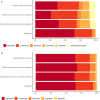The cellular composition of chronic subdural hematoma
- PMID: 38724806
- PMCID: PMC11082037
- DOI: 10.1007/s00701-024-06101-2
The cellular composition of chronic subdural hematoma
Abstract
Introduction: The pathophysiology of chronic subdural hematoma (CSDH) remains to be fully understood. Basic knowledge of the composition and features of cells in the CSDH fluid may contribute to the understanding of the seemingly complex processes involved in CSDH formation and recurrence. This study is the first to examine the composition of cells and of cellular features in both systemic blood and subdural fluid from CSDH patients. We hypothesized that the cellular composition and features in the hematoma fluid may be; 1) different from that in the systemic blood; 2) different between patients with and without recurrence; 3) and different between the first and second operation in patients with recurrent CSDH.
Methods: Systemic blood and subdural hematoma fluid were collected from CSDH patients with and without recurrent CSDH at the time of primary and secondary surgery. Analyses of cells and cellular features included total number of white blood cells, erythroblasts, reticulocytes, platelets, neutrophilocytes, lymphocytes, monocytes, eosinophils, basophils, reticulocytes, immature granulocytes, mean corpuscular cell volume (MCV), mean corpuscular hemoglobin, mean corpuscular hemoglobin concentration, hemoglobin and hematocrit.
Results: Of the 85 included patients, 20 patients were operated for a recurrent CSDH within 90 days follow-up. All cells found in the systemic blood were present in the CSDH fluid, but the composition was different (p < 0.0001). MCV was higher in the hematoma fluid from the primary operation of patients later developing a recurrent CSDH compared to patients not developing recurrence (p = 0.009). Also, the percentage distribution of inflammatory cells in hematoma fluid from patients with recurrent CSDH was different between the first and second operation (p = 0.0017).
Conclusion: This study is the first to investigate the cellular composition of CSDH fluid. Compared to systemic blood and to a reference distribution, an increased number of immune cells were present in the hematoma fluid, supporting an inflammatory component of the CSDH pathophysiology. MCV was higher in the subdural fluid at time of the first operation of CSDH patients later developing recurrence.
Clinical trial registration: The study was approved by the Scientific Ethical Committee of the Capital Region of Denmark (Journal no. H-20051073.
Keywords: Cellular profile; Inflammatory cells; Personalized treatment; Risk profile; Subdural fluid.
© 2024. The Author(s).
Conflict of interest statement
All authors certify that they have no affiliations with or involvement in any organization or entity with any financial interest (such as honoraria; educational grants; participation in speakers' bureaus; membership, employment, consultancies, stock ownership, or other equity interest; and expert testimony or patent-licensing arrangements), or non-financial interest (such as personal or professional relationships, affiliations, knowledge or beliefs) in the subject matter or materials discussed in this manuscript.
Figures


References
-
- Andersen-Ranberg NC, Poulsen FR, Bergholt B, Hundsholt T, Fugleholm K (2017) Bilateral chronic subdural hematoma: unilateral or bilateral drainage? J Neurosurg 126(6):1905–1911 - PubMed
-
- Ansari-Lari MA, Kickler TS, Borowitz MJ (2003) Immature granulocyte measurement using the Sysmex XE-2100. Relationship to infection and sepsis. Am J Clin Pathol 120(5):795–799 - PubMed
-
- Arbiol-Roca A, Imperiali CE, Montserrat MM, Cerro AS, Bosch de Basea AC, Navarro LS, Dot Bach D, Politi JV (2018) Reference intervals for a complete blood count on an automated haematology analyser Sysmex XN in healthy adults from the southern metropolitan area of Barcelona. Ejifcc 29(1):48–54 - PMC - PubMed
-
- Ayyildiz H, Karabulut N, Kalayci M (2018) Relationship between red blood cell distribution width and schizophrenia. Intl J Med Biochem 1(1):15–19
-
- Cetın N, Kocaturk E, Tufan AK, Kıraz ZK, Alatas O (2023) Immature granulocytes as biomarkers of inflammation in children with predialysis chronic kidney disease. Pediatr Nephrol 38(1):219–225 - PubMed
Publication types
MeSH terms
LinkOut - more resources
Full Text Sources

